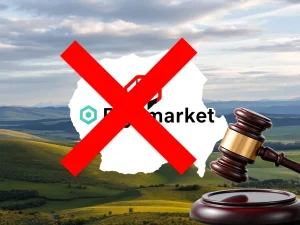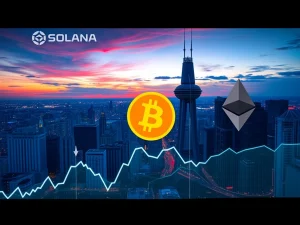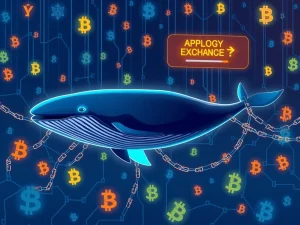Alarming ZORA Price Surge: Is CEX Manipulation Inflating Its Value?

The cryptocurrency world is buzzing about ZORA’s staggering 931% ZORA price surge over the past month. While such gains usually spark immense excitement and draw investors in, a deeper look at the underlying data reveals a puzzling discrepancy. Many analysts are now raising red flags about potential CEX manipulation, prompting a crucial discussion about market transparency and the true drivers of value in the crypto space. Could this seemingly meteoric rise be built on a shaky foundation?
The ZORA Price Paradox: A Closer Look at the Surge
ZORA has indeed captivated the market with an astounding 931% price increase in just one month, seemingly embarking on an independent altcoin rally. This rapid appreciation has naturally attracted significant attention, positioning ZORA as a trending asset. However, this impressive performance stands in stark contrast to its fundamental on-chain activity. BlockBeats reported on July 27 that despite the massive surge, on-chain data reveals there has been almost no single transaction exceeding $500,000 in recent activity. This unusual pattern has led experts, including on-chain analyst Ai Auntie, to question the authenticity of the surge.
The absence of large off-chain transfers, which are typically indicative of significant institutional or whale movements and organic demand, suggests that liquidity might be funneled through centralized exchange (CEX) wallets rather than public blockchain transactions. This pattern is often associated with coordinated trading strategies or artificial volume generation, raising concerns about the organic nature of ZORA’s rapid ascent and its implications for the broader crypto market.
Is CEX Manipulation Driving ZORA’s Gains?
The trading dynamics surrounding ZORA further underscore potential vulnerabilities and highlight the significant, sometimes opaque, role of centralized exchanges. Let’s break down the trading landscape:
- Spot Trading Dominance: Coinbase accounts for a substantial $82.6 million in ZORA spot trading volume over 24 hours. This indicates significant direct buying and selling activity on a major CEX.
- Derivatives Market Leadership: Binance, another leading CEX, leads the derivatives market with a staggering $13.54 billion in ZORA trading volume.
This creates an astonishing 16.4-fold gap between derivatives and spot activity. Such a significant disparity can indicate that speculative derivatives trading, often facilitated by CEXs, might be driving the narrative and price without commensurate underlying spot liquidity. This imbalance fuels suspicions of CEX manipulation, where large players might be exploiting exchange-based liquidity pools to distort price signals, potentially creating a false sense of demand and attracting unsuspecting retail investors.
The concern here is that if the price is being primarily driven by high-leverage derivatives trading on centralized platforms, rather than genuine asset accumulation on-chain, the current valuation could be artificially inflated and prone to rapid corrections.
Understanding ZORA’s Tokenomics and Future Supply Shocks
Beyond the immediate trading volumes and suspicious on-chain data, understanding ZORA’s tokenomics is crucial for assessing its long-term sustainability and potential future price stability. Here’s what we know about its supply structure:
- Circulating Supply: Currently, only 35% of the total ZORA supply is in circulation. This relatively limited circulating supply, combined with high perceived demand (whether organic or artificial), can easily lead to significant price volatility.
- Locked Supply: A substantial 65% of the total supply remains locked in investor, treasury, and team wallets. This large locked portion represents a future supply overhang that could dramatically alter market dynamics.
A critical factor to watch is the scheduled release of these locked tokens, which is set to begin in October 2024. As this substantial portion of the supply enters the market, it could significantly impact liquidity and price stability, potentially leading to downward pressure if demand doesn’t keep pace with the increased supply. GSR Markets, the designated liquidity provider for ZORA, will play a critical role in managing market depth during this transition period, aiming to mitigate potential supply shocks. However, their ability to absorb such a large influx without impacting the ZORA price remains to be seen.
Why Does On-Chain Activity Matter for Crypto Market Health?
In typical bull markets for altcoins, significant retail and institutional participation is evident through large, transparent transfers on the blockchain. This robust on-chain activity signifies genuine adoption, strong demand, and a healthy flow of capital into the asset. When large amounts of capital move between wallets, it reflects real buying and selling pressure from a diverse set of market participants. The stark contrast with ZORA’s current situation, where large on-chain transactions are notably absent, is a significant cause for concern for the overall health of the asset and its valuation.
Analysts often note that such anomalies can coincide with CEX-driven pump-and-dump schemes or token dumping strategies, where tokens are moved off-chain or traded internally on exchanges to create artificial volume before being offloaded onto unsuspecting buyers. While concrete evidence for such activities remains unverified in ZORA’s case, the situation highlights growing concerns about the transparency of CEX activities within the broader decentralized finance (DeFi) ecosystem. The potential for market makers and institutional players to exploit centralized exchange mechanisms to manipulate prices poses a risk to the integrity of the entire crypto market, eroding trust and creating unfair conditions for retail investors.
Navigating the Crypto Market: What Investors Need to Know About ZORA
As ZORA approaches its October token release phase, investors are wisely scrutinizing whether the current price momentum is sustainable or artificially sustained. The interplay between CEX dominance, a limited circulating supply, and the absence of large on-chain flows presents a complex landscape for market participants. Here are some actionable insights to help you navigate this challenging environment:
- Exercise Due Diligence: Look beyond the impressive percentage gains displayed on charts. Investigate the underlying on-chain activity and trading volumes across different platforms, paying close attention to the source of liquidity.
- Understand Supply Dynamics: Be acutely aware of the upcoming token unlock schedule and its potential impact on price and liquidity. A sudden influx of supply can significantly dilute value.
- Question High Volume, Low Transparency: If a token shows massive trading volume primarily on derivatives or within CEX wallets without corresponding large public blockchain transactions, proceed with extreme caution. This often signals potential CEX manipulation.
- Diversify and Manage Risk: Given the uncertainties surrounding ZORA, avoid overexposure to single assets that exhibit such anomalous behavior. Diversifying your portfolio can mitigate potential losses.
- Stay Informed: Follow reputable on-chain analysts and news sources to get a comprehensive view of market movements, not just the headlines.
The ZORA situation serves as a potent reminder of the opaque corners that can exist even in the supposedly transparent world of cryptocurrency. Vigilance and informed decision-making are paramount for protecting your investments in the dynamic crypto market.
Summary: The ZORA Enigma
ZORA’s astonishing 931% surge has certainly grabbed headlines, but the story runs deeper than just impressive gains. The significant discrepancy between its soaring ZORA price and the near absence of large on-chain activity raises serious questions about potential CEX manipulation. With a large portion of its supply still locked and an October 2024 release looming, investors must approach ZORA with caution, understanding the complex interplay of centralized exchange dynamics and underlying tokenomics that could shape its future in the volatile crypto market. The current situation underscores the critical need for transparency and robust analysis in an evolving digital asset landscape.
Frequently Asked Questions (FAQs)
1. What is the main concern regarding ZORA’s recent price surge?
The main concern is that ZORA’s 931% price surge is not supported by significant on-chain activity, particularly the absence of large transactions (over $500,000). This discrepancy suggests the possibility of artificial price inflation or CEX manipulation rather than organic market demand driven by genuine adoption.
2. How might centralized exchanges (CEXs) be involved in ZORA’s price action?
Analysts suspect CEXs might be involved through coordinated trading strategies, artificial volume generation, or by funneling liquidity through exchange wallets instead of public blockchain transactions. The vast disparity between spot and derivatives trading volumes on platforms like Coinbase and Binance also points to potential manipulation within the centralized exchange environment, where large players could be distorting the ZORA price.
3. What are ZORA’s tokenomics, and why is the October 2024 release significant?
ZORA’s tokenomics indicate that only 35% of its total supply is currently circulating, with a substantial 65% locked in investor, treasury, and team wallets. The release of these locked tokens, scheduled to begin in October 2024, could significantly increase the circulating supply. This influx might impact the ZORA price and its stability as market liquidity changes and supply potentially outstrips demand.
4. Why is a lack of large on-chain transactions a red flag for a cryptocurrency?
A lack of large on-chain activity in a surging asset is a red flag because it typically indicates an absence of significant retail or institutional buying interest that would involve substantial transfers on the blockchain. This can suggest that the price is being driven by artificial means, such as internal exchange movements or speculative derivatives trading, rather than genuine demand in the broader crypto market.
5. What should investors consider before investing in ZORA?
Investors should conduct thorough due diligence, looking beyond just price gains. It’s crucial to investigate the actual on-chain activity, understand the token’s tokenomics and upcoming supply releases, and be aware of the potential for CEX manipulation. Prudence, diversification, and robust risk management are advised, especially for assets exhibiting such unusual trading patterns.









